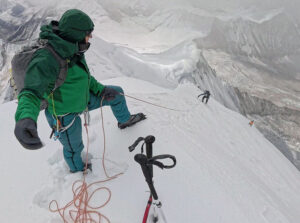With international flights scheduled to begin on August 17, Nepal authorities have also granted trekking and expedition agencies permission to operate. Local companies are ready to outfit expeditions to Everest, Manaslu, Dhaulagiri, Cho Oyu and a number of 7,000’ers and 6,000’ers. The only element still missing is — mountaineers.
International flights can land on Nepalese soil through a progressive process. It starts by allowing flights from “safer” countries and imposing quarantines until mid-August. The plan is to slowly lift these restrictions and have a regular flow of flights to Kathmandu by September.
Nepal’s Department of Tourism is ready to issue climbing permits for autumn and is currently preparing safety procedures for tour operators and staff. Local outfitters, such as Tashi Lakpa’s Seven Summits Treks, will offer climbs of Everest-Lhotse, Manaslu, Makalu and Dhaulagiri. Meanwhile, Mingma G’s Imagine Nepal has set its sights on 7,140m Nemjung, should clients arrive. Nirmal Purja, currently in Chamonix, also announced Everest-Lhotse and Manaslu for anyone interested.
The problem is, it takes two shores to build a bridge. COVID-19 cases are still soaring in the Americas, Russia and the Middle East, and even Europe is busy trying to control new outbreaks while struggling with crippled economies. All around the world, countries are rife with unemployment. No wonder that Himalayan climbing has declined on everyone’s list of priorities.
In the Himalaya itself, the risk of contagion remains too high just to relax and enjoy the scenery. While Nepal’s figures are still moderate, neighboring India has the third highest number of cases worldwide, according to Johns Hopkins University’s Coronavirus Resource Center.
Under such circumstances, international outfitters are cautious. “As much as I would love a return to normal, I’m not planning on sending any groups to Nepal for the post-monsoon,” Adventure Contultants‘ CEO Guy Cotter told ExplorersWeb. “For one, I’m afraid of accidentally introducing COVID to the Khumbu. The Khumbu is a perfect bubble that needs to stay closed until this pandemic is resolved.” Note that Adventure Consultants is based in New Zealand, one of the countries that has managed the pandemic most successfully.

Five-time Everest summiter and AC’s CEO Guy Cotter will wait for conditions to improve before resuming expeditions in the Himalaya. Photo: Adventure Consultants
Cotter also mentioned further issues, including travel restrictions from destination countries, insurance obstacles, crowded lodges, the need for rapid COVID testing in the (inevitable) event a person gets a cold in the Khumbu, issues with repatriation during an emergency, staff quarantine costs and the difficulty of getting staff back into their home countries at the end of the season.
“The situation we’re in is similar to climbing a mountain: If you want to make the ascent safely, you hold back until all the conditions are favorable,” said Cotter.
Innsbruck-based guide Lukas Furtenbach shares this point of view. His company will only operate at home in the Alps for the rest of 2020, until finances and the vaccine and outbreak situations are clearer.

Will Everest remain lonely for the rest of 2020, as it was for Jost Kobusch at his Base Camp below the Lho La last winter? Photo: Diego Martinez/Alex Txikon expedition
Will this mean that no one is going to Nepal? Not necessarily. Independent climbers or small teams may still grab a chance to do something without the typical crowds. Those who have survived the illness and may be temporarily immune may feel safe enough. Others could simply consider the risks acceptable or little different from coexisting with the virus at home. Finally, financial issues are serious for most of us but not for those few with solid fortunes.
The determined ones, however, may still have to consider logistical issues: They will not find crowds on Manaslu, but nor will they find big teams to share the route-fixing. Likewise, they have a unique chance to experience Everest for themselves but they will need to learn from the recent winter expeditions and either find a Sherpa team to assist them in the Khumbu icefall, or dare a light, nearly-alpine style climb.





